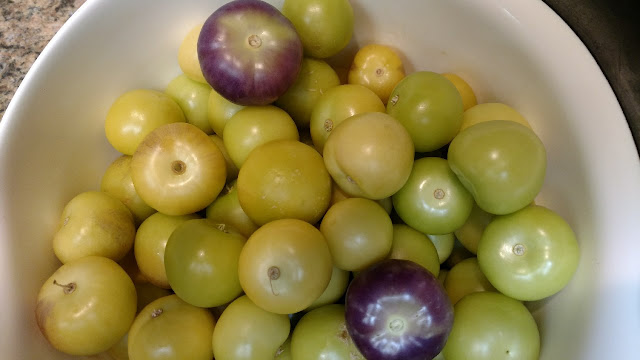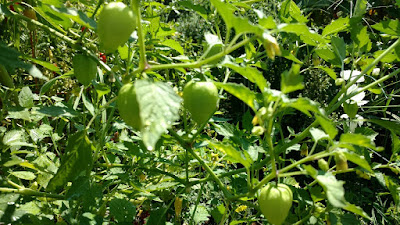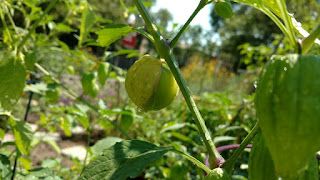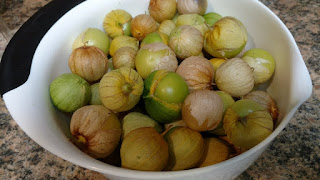Tomatillos gone wild!
Recipe: What to do with too many tomatillos? Try this simple salsa verde
 |
| These tomatillos are ready to be cooked into salsa verde. See recipe below. |

|
Tomatillos love August in Sacramento.
Of all the crops in my summer garden, tomatillos survived the heat and smoke better than any other vegetable (or fruit) -- and I hadn't planted a single one. Of the dozen tomatillo bushes in my plot, every one was a volunteer.
Where peppers seem stunted and eggplants slow to get going, the tomatillos became opportunists. They filled in the gaps around the blueberries and strawberries, then invaded the tomatoes. Those half-wild plants grew faster and stronger than anything else (including the squash and sunflowers).
By late July, the lush green vines were covered with little paper lanterns, the future husks for the tomatillos. Those protective wrappings also helped shield the tender fruit from leaf-footed bugs and falling ash.
Now, those lanterns are busting out all over as the tomatillos rapidly ripen. When the husks split, the tomatillos are ready to pick. (If tomatillos are allowed to fully mature to yellow, their seeds harden and become more pronounced.)
This August, I have tomatillos by the hundred. What to do with that green (and purple) bounty? That’s a lot of salsa.

|
Native to Mexico and Guatemala, tomatillos have been cultivated in the Americas for centuries. Tomatillo, which means "little tomato," also is known as Mexican ground cherry and husk tomato.
Processing tomatillos takes work. They are not just weird tomatoes with wrappers, but a cousin in the nightshade family. Every part of the tomatillo plant is poisonous except the fruit. Yes, the husk can be toxic and the waxy stuff on the fruit that keeps the husk attached is not good for you, either; that's why it tastes so bitter.
Before eating, tomatillos need a bath and a good scrub. A little dish soap helps remove the husks and sticky coating. Place the tomatillos in the sink or dishpan, cover with lukewarm water and add a teaspoon or two of mild dish detergent. Let soak for 2 or 3 minutes. Then, gently rub off the husks and wax, one tomatillo at a time. With husk and wax removed, the tomatillo skin will become slick and shiny. Rinse in clean water and pat dry.
Raw tomatillos tend to be very tart. After husk removal, they can be used fresh, roughly chopped in salsas or thinly sliced and added to salads.
Cooking mellows their flavor and brings out their natural sweetness. That’s why I prefer to use them in sauces such as a thick salsa verde for topping tacos or burritos, or as a cooking sauce for enchiladas.
That sunny, summery taste will warm many a Southwestern winter meal.
Deb’s simple salsa verde

before they can be cooked. |
3 pounds tomatillos
Water
Salt to taste
2 tablespoons vegetable oil
1 large yellow onion, finely chopped
1 large Anaheim chile, stemmed, cored and finely chopped
Instructions:
In a large heavy pot, put enough water to cover the bottom of the pot with an inch of water. Add cut tomatillos. Sprinkle salt (about 1/2 to 1 teaspoon) over tomatillos. Bring to boil, then cover. Reduce heat and simmer for 10 to 15 minutes, until tomatillos are very tender.
Drain tomatillos, reserving 1 cup of cooking liquid. In a food processor or blender, process tomatillos in batches until finely chopped.
Rinse the pot, then return it to the stove. Over medium heat, heat oil in the pot and add chopped onion and pepper. Sauté until onion is translucent.
Add the processed tomatillos to the onion-pepper mixture. Simmer for about 5 minutes, stirring often.
Return the tomatillo mixture to the food processor. Again working in batches, process tomatillo mixture until very smooth and creamy.
Add reserved cooking liquid to the processed tomatillo mixture as needed for desired consistency. In the final sauce (thinner for use as a cooking sauce, thicker for use as a condiment).
This sauce keeps well in a sealed container in the refrigerator (up to 2 weeks) or in the freezer (up to 1 year).
